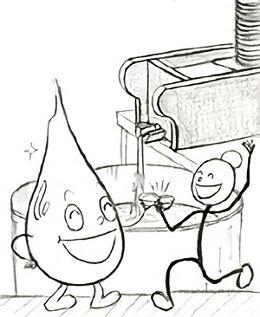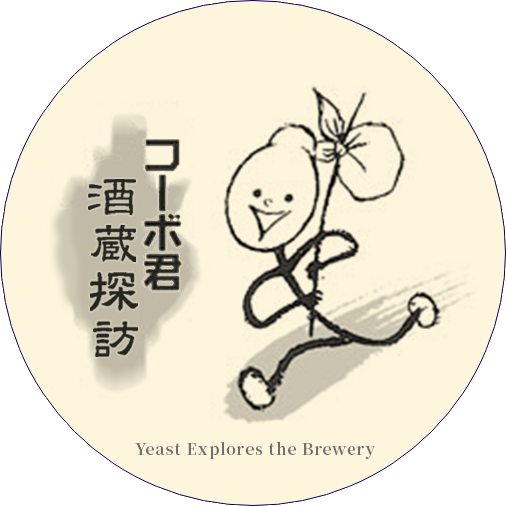| Yeast |
“Hey! Genshu (‘raw sake’), congratulations on your birth! I’d like to talk to you.” |
| Genshu |
“OK, Yeast, fire off your questions.” |
| Yeast |
“How does one decide when to start pressing the main mash (moromi)?” |
| Genshu |
“That’s indeed a critical moment. It has to be done at the moment that taste, aroma, and alcohol percentage are all in best balance. The yeast (like you, Yeast) transforms the sugars in the mash into alcohol. Therefore sweetness decreases, and acidity, alcohol content as well as complexity will increase. Based on long years of experience, the master brewer (toji) can predict what the situation will be by tomorrow.” |
| Yeast |
“So pressing takes place at the best moment.” |
|
 |
| Genshu |
“An important point is whether the yeast still has vitality or not.” |
| Yeast |
“I’m full of confidence!” |
| Genshu |
“Yes, you’re kimoto yeast, you don’t need to worry.” |
| Yeast |
“Leave it to me! There are various ways to press the sake, aren’t there?” |
| Genshu |
“Yes, the normal way is to use a hydraulic press called yabuta, but Daishichi also has a traditional fune press. The mash is put in bags and placed in the fune and the sake naturally drips out of the spout of the fune. A third way is fukuro-tsuri, to hang up the bags with moromi and gather the sake which drops out.” |
| Yeast |
“Important is to have the sake as little as possible come into contact with air, and also to use as little pressure as possible.” |
| Genshu |
“In that way the aroma is richer and the taste cleaner.” |
| Yeast |
“I see! What happens with the sake immediately after pressing?” |
| Genshu |
“Different from moromi, the newly pressed sake is transparent, but it does have some color. Good sake is not only amber colored, but has a greenish tint. But that color disappears during maturation. When you drink it just after pressing, you can still recognize a bit of the carbon gas of fermentation. Almost all the yeast has been removed with the sake cake during the pressing, but the enzymes that have been dissolved into the sake are still alive.” |
| Yeast |
“What effect have those enzymes?” |
| Genshu |
“They help the new, coarse sake to grow. Some days after pressing, the taste of the sake becomes sweeter, and the aroma riper. In the sediment at the bottom also the yeast is still alive. For that reason, the new sake changes every moment. But if it changes too much, the balance of the taste will be lost.” |
| Yeast |
“What can be done about that?” |
| Genshu |
“The top clear layer is removed to another tank, and passed through a filter, to remove the sediment and other tiny solid matter. In that way, the quality will keep, even without strong refrigeration.” |
| Yeast |
“So that is namazake (unpasteurized sake)! Tasty and refreshing. But because the enzymes are still alive, the sake will still be undergoing changes, won’t it?” |
| Genshu |
“Therefore sake is pasteurized before long storage. Pasteurizing means low temperature disinfection at 60 degrees C. Even at that low temperature the activity of the enzymes is completely stopped. Due to the synergistic effect of the alcohol, this type of disinfection is sufficient.” |
| Yeast |
“After that we only have to wait until the sake gradually matures...” |
| Genshu |
“I’m happy to have been born...” |
| Yeast |
“I’m glad you are so fine.” |





